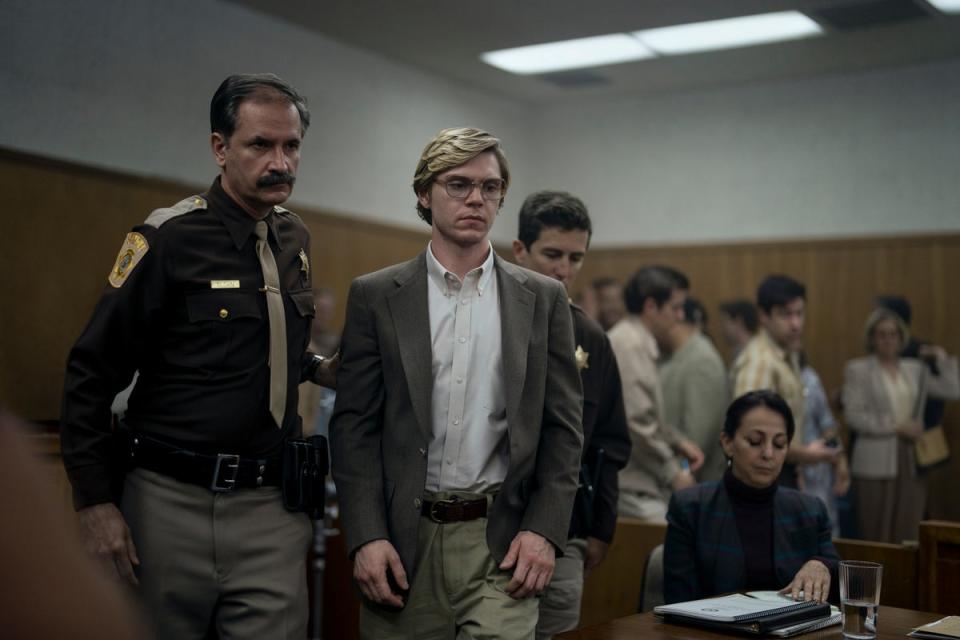Why only one episode of Ryan Murphy’s ‘Dahmer’ comes close to ‘responsible’ art

There’s probably no such thing as compassionate television about a serial killer. It’s impossible to honour victims without re-traumatising their families. And maybe you can’t explore a murderer’s damaged psyche – the rough personal history that preceded their terrible crimes – without evoking pity.
Right now, the most watched show on Netflix is Dahmer – Monster: The Jeffrey Dahmer Story. Viewers have spent as many hours in front of the macabre Ryan Murphy miniseries as they have Netflix’s next seven most popular programmes combined. Across the world, true crime has never been this popular – or chilling. The 10-parter opens with Jeffrey Dahmer, played with menacing stoicism by Murphy’s frequent collaborator Evan Peters, cleaning the blood from what I’m pretty sure is an electric carving knife. It’s hard for me to say because I was already watching through my fingers.
An hour later, the first episode ends with a man whose surname we never learn, running for his life. If there is a way to make responsible art about the man who killed and dismembered 17 victims, mostly young men of colour, before being apprehended, Dahmer – Monster isn’t it.
And yet, in its sixth episode, called “Silenced”, the series seems tempted by the possibility.
That episode rewinds the clock to 1960, the year Tony Hughes was born in a Milwaukee hospital. We watch his mother, bathed in yellow light, smile through exhaustion as she holds her son for the first time. And we stay with Tony as he grows. We’re there when a doctor delivers the bad news to his family that he’s permanently deaf, likely as a consequence of antibiotics he was administered as a newborn.
The episode remains in Tony’s hands. As an adult, he takes his resume from shop to shop looking for a job. He heads to gay clubs with his friends, looking for love. Tony, played with heartbreaking warmth by Deaf U star Rodney Burford, isn’t just the centre of this episode. The circumstances of his life determine its shape. Scenes slow down so that Tony can write out his thoughts in the small notebook he keeps on-hand for communicating with people who can’t sign.
At times, “Silenced” loses audio altogether, so we can experience Tony’s story in a noiseless approximation of how he lived. The episode is nearly a third over before he even meets the man who will end his life.
There are other episodes that evoke something of what it felt like to be in Dahmer’s company, but none that so radically quit his point of view. As we watch the killer bring a man back to his apartment in the pilot, for example, his victim’s fear is only half in focus. We hear the perilous sound of the deadbolt clicking into place, like something from a horror film, but we also watch how methodically Dahmer does it. This is a scene about what it feels like to turn the lock.

Before “Silenced”, the befuddlingly titled Dahmer – Monster: The Jeffrey Dahmer Story is devoted to a retelling of Dahmer’s life, not with undue sympathy (he is, of course, branded a monster) but with plenty of detail (maybe that’s why his name is in the title twice?). Most of his victims get the scantest of screentime.
But for the show’s standout episode, Tony feels like the protagonist. It gives the series something resembling narrative stakes. Tony has a beautiful, loving family that searches for him when the police don’t. With even a slice of his life depicted, the show stopped drifting in the direction of Dahmer’s arrest and became something genuinely arresting: a story of a family’s loss and not just their pain, too real to look away from.

 Yahoo Movies
Yahoo Movies 